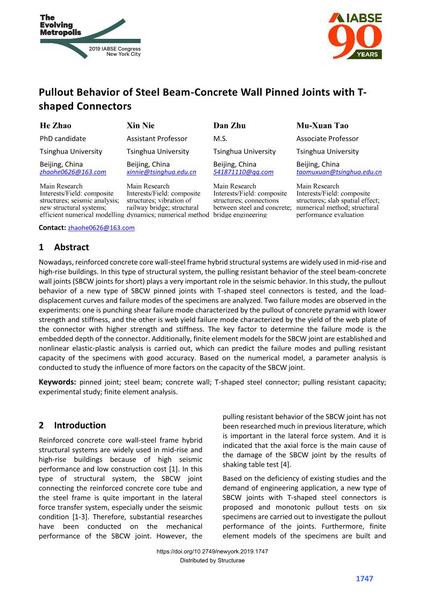Pullout Behavior of Steel Beam-Concrete Wall Pinned Joints with T- shaped Connectors

|
|
|||||||||||
Bibliografische Angaben
| Autor(en): |
He Zhao
(Tsinghua University)
Xin Nie (Tsinghua University) Dan Zhu (Tsinghua University) Mu-Xuan Tao (Tsinghua University) |
||||
|---|---|---|---|---|---|
| Medium: | Tagungsbeitrag | ||||
| Sprache(n): | Englisch | ||||
| Tagung: | IABSE Congress: The Evolving Metropolis, New York, NY, USA, 4-6 September 2019 | ||||
| Veröffentlicht in: | The Evolving Metropolis | ||||
|
|||||
| Seite(n): | 1747-1752 | ||||
| Anzahl der Seiten (im PDF): | 6 | ||||
| DOI: | 10.2749/newyork.2019.1747 | ||||
| Abstrakt: |
Nowadays, reinforced concrete core wall-steel frame hybrid structural systems are widely used in mid-rise and high-rise buildings. In this type of structural system, the pulling resistant behavior of the steel beam-concrete wall joints (SBCW joints for short) plays a very important role in the seismic behavior. In this study, the pullout behavior of a new type of SBCW pinned joints with T-shaped steel connectors is tested, and the load- displacement curves and failure modes of the specimens are analyzed. Two failure modes are observed in the experiments: one is punching shear failure mode characterized by the pullout of concrete pyramid with lower strength and stiffness, and the other is web yield failure mode characterized by the yield of the web plate of the connector with higher strength and stiffness. The key factor to determine the failure mode is the embedded depth of the connector. Additionally, finite element models for the SBCW joint are established and nonlinear elastic-plastic analysis is carried out, which can predict the failure modes and pulling resistant capacity of the specimens with good accuracy. Based on the numerical model, a parameter analysis is conducted to study the influence of more factors on the capacity of the SBCW joint. |
||||
| Stichwörter: |
Finite-Elemente-Analyse
|
||||
